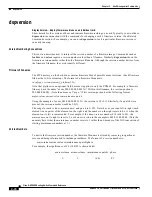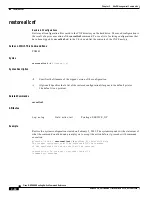
2-75
Cisco MGX 8850 Routing Switch Command Reference
Release 2.0, Part Number 78-10467-04 Rev C0, October 2001
Chapter 2
Shelf Management Commands
loadrev
loadrev
Load Revision
Downloads a firmware image from the FW directory on the disk to flash memory on the targeted card.
Executing is the first step in performing a graceful firmware upgrade. A graceful revision change
preserves the configuration of the card and minimizes any data loss that could result from the brief
disruption in service.
Although loadrev runs on a PXM45, the target can be either a service or the PXM45 itself. The system
automatically determines which card in a redundant setup is active and which is standby. Specifying the
active card slot is sufficient. For example, if a PXM45 is the target, you can specify either slot 7 or slot
8 regardless of the active slot number.
The sequence of commands for a graceful revision change appear in the following list. See
Table 2-10
and
Table 2-11
for a clarification of the various states within this sequence.
1.
loadrev loads a firmware version from the hard disk to a card’s memory. In a non-redundant card
setup, loadrev does not cause the system to reset the card.
2.
runrev causes the primary card to start running the new version. For a redundant pair of cards, the
standby becomes the active card then starts running the new version.
3.
If an unacceptable problem occurs, the optional abortrev command restores the previous version of
firmware as well as the previous database contents.
4.
commitrev declares the new primary version to be acceptable and removes the old primary from
main memory (but not the hard disk).
A graceful upgrade takes a single card or a redundant card pair through different stages. Also, if you
must execute abortrev on a redundant pair, the card (or possibly both cards in a redundant pair) are reset.
The stages of a graceful upgrade and the reset actions appear in
Table 2-10
for a single-card upgrade and
Table 2-11
for a redundant-pair upgrade.
The tables start by showing that, initially, the primary and secondary versions of firmware are 2.x, so
the only possible operational version is 2.x. The loadrev command loads a generic version called 2.y,
and the upgrade sequence progressively changes the primary and secondary firmware versions.
Note
Of special note in
Table 2-11
, runrev causes the standby card to become the active card. The
reversed location of the “Active” and “Standby” columns shows the changed states.
Table 2-10
Single-Card Upgrade From 2.x to 2.y
Firmware
Status
Initial Version
After loadrev
After runrev
After
commitrev
Primary
2.x
2.x
2.y
2.y
Secondary
2.x
2.y
2.x
2.y
Operational
2.x
2.x
2.y
2.y
After abortrev,
the card is reset.
















































